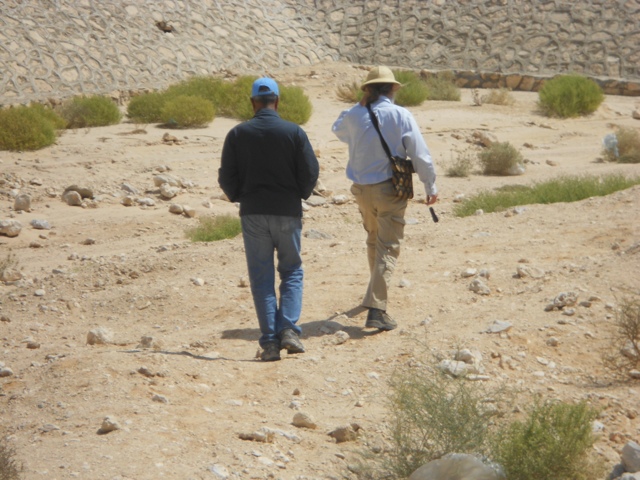For so many years I have dreamed of Amarna, studied its history, looked up its topography, followed up on the discoveries being made there. For all those years it was to me like a Holy Grail, an impossible quest. The site is not easy to reach and not part of any popular tourist circuit. I had long ago accepted the fact that even if I traveled to Egypt, Amarna would remain out of reach to a mere mortal like me...
When I saw that the City of Akhenaten was included in Ancient World Tours "Pharaohs of the Sun" itinerary, I could not believe my luck. That was the clincher for me.
So here I am, for a second day of exploration. But that's just the beginning of it. Having Dr. Barry Kemp as our guide here is like having St. Peter give us a private guided tour of Heaven. No kidding.
We start the day by resuming where we left off yesterday, looking at the remains of the central royal palace and visiting the Great Aten Temple. The sheer size of the latter is impressive, but hearing Dr. Kemp describing the hundreds of offering altars that filled the inner courts and outer perimeter of the temple inspires awe. The modern-day village is encroaching upon the archaeological site, illegal construction, piles of trash and small cemeteries coming right up to the foundations of the 3,500 year old shrine. The locals do not seem to care about their ancient heritage, using the irreplaceable ruins as a place to dry cow manure in the sun, to be used as fuel in bread ovens.
We board the bus again for the drive to the royal tombs. Yes, the royal tombs of Amarna! The drive is surprisingly long, several kilometres, to reach the tomb of Akhenaten. It truly is a royal tomb of regal proportions. It is also very well appointed with modern amenities; wooden staircases and flooring, good lighting throughout, metal railings and such. Dr. Kemp explains and interprets the surviving decoration in each of the rooms. Fascinating details, poignant scenes of mourning, possible depiction of the birth of Tutankhaten and death in childbirth of his yet unidentified mother.. I stand in the main burial chamber right next to the slightly raised stone plinth where Akhenaten's pink granite sarcophagus once stood (it has now been restored from fragments and is displayed in the outdoor garden of the Egyptian Museum in Cairo). I just can't believe it!
Two more unnamed and unfinished tombs nearby show that intention was to create the equivalent of a new "Valley of the Kings" here at Amarna.
We follow with a visit to the "Northern Tombs", reached at the end of another very long staircase up the cliff. My bad hip and knee are screaming bloody murder but, with determination, self-sacrifice and an ample supply of Advil pain killers -- not necessarily in that order -- I soldier on... I've come all this way, so I might as well do it! Two of the tombs show detailed depictions of the Great Temple, a priceless boon to Egyptologists trying to understand the layout of the actual ruins down on the plain. One of the tombs had been converted to an early Christian Church in antiquity, while the other shows a rare meteorological event surrounding the Aten sun disk, with an inverted rainbow-like halo around it, a unique depiction in ancient Egypt.
Another gruelingly long staircase takes us to one of the boundary stelae that the king had set to delineate his new city. The much ruined monument was carved directly into the limestone cliff. The text is still largely readable, while the stone statues have suffered the brunt of the wrath that followed the return of orthodoxy.
We end the day at the so-called Northern Palace. Dr. Kemp has done extensive excavation and restoration work here. It is all very impressive.
I hope I get to come back here some day, to spend more time.




No comments:
Post a Comment